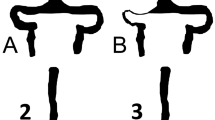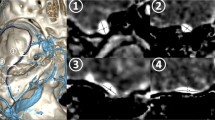Abstract
Introduction
The premature fusion of the metopic suture may be associated with the presence of emissary veins (EV) and abnormally large pericerebral cerebrospinal fluid (CSF) spaces which suggest an associated focal disturbance in CSF dynamics. The incidence of such findings and their potential significance in terms of management of the disease have not been fully elucidated. The aim of this study is to investigate whether these phenomena identify specific subtypes of trigonocephaly. In such a direction, we evaluated the volume of the pericerebral CSF spaces and their relationship to the morphology (“Ω,” “V,” or flat type) of the prematurely fused metopic suture and to the value of the interfrontal angle value on the grounds of computed tomographic (CT) scan examinations.
Method
The preoperative brain CT scans of 74 children (52 boys, 22 girls) with trigonocephaly who had undergone fronto-orbital remodeling were evaluated. The volume of the pericerebral CSF spaces and the value of the interfrontal angle were calculated. The type of intracranial notch was studied and classified according to its shape on the preoperative CT scan: a groove “Ω,” a ridge/“V” ridge or absent when flat and evidence of emissary veins related to the abnormally fused suture.
Results
Preoperatively, an endocranial metopic groove or ridge was seen in 70% of the children. Emissary veins were identified in 34 of 74 patients (45%), at a mean distance of 2.04 cm (1.18-2.94 cm) from the nasion. The presence of large pericerebral CSF spaces significantly correlated with the presence of EV (p < 0.05), with the “Ω” type (p < 0.05) and with interfrontal angles under 134° (p < 0.005).
Conclusions
Metopic suture early fusion shows an association between EV, pericerebral CSF spaces, and the “Ω” groove appearance of the suture. This association identifies a specific subgroup in which the presence of emissary veins and large pericerebral CSF spaces is an indicator of local venous hypertension due to the sagittal sinus constriction within an osseous groove created by the abnormal suture fusion process. The implications for the surgical management and long-term results as compared to trigonocephalic children with small or absent normal peripheral spaces and EV are still to be determined.





Similar content being viewed by others
References
Shuper A, Merlob P, Grunebaum M, Reisner S (1985) The incidence of isolated craniosynostosis in the newborn infant. Am J Dis Child 139:85
Kolar JC, Salter EM (1997) Preoperative anthropometric dysmorphology in metopic synostosis. Am J Phys Anthropol 103:341
Van der Meulen J, Van der Hulst R, Van Adrichem L, Arnaud E, Chin-Shong D, Duncan C, Habets E, Hinojosa J, Mathijssen I, May P, Morritt D, Nishikawa H, Noons P, Richardson D, Wall S, van der Vlugt J, Renier D (2009) The increase of metopic synostosis: a pan-European observation. J Craniofac Surg 20:283–286
Di Rocco F, Arnaud E (2009) Renier D.(2009) Evolution in the frequency of non syndromic craniosynostosis. J Neurosurg Pediatr 4:21–25
Di Rocco F, Arnaud E, Meyer P, Sainte-Rose C, Renier D (2009) Focus session on the changing “epidemiology” of craniosynostosis (comparing two quinquennia: 1985-1989 and 2003-2007) and its impact on the daily clinical practice: a review from Necker Enfants Malades. Childs Nerv Syst 25(7):807–811
Lam WW, Ai VH, Wong V, Leong LL (2001) Ultrasonographic measurement of subarachnoid space in normal infants and children. Pediatr Neurol 25:380–384
Wood B, Mendoza C, Albert K, Myers E, Safdar N, Linguraru M, Rogers G (2016) What’s in a name? Accurately diagnosing metopic craniosynostosis using a computational approach. Plast Reconstr Surg 137(1):205–213
Posnick JC, Lin KY, Chen P, Armstrong D (1994) Metopic synostosis: quantitative assessment of presenting deformity and surgical results based on CT scans. Plast Reconstr Surg 93:16
Di Rocco F, Gleizal A, Lohkamp L, Szathmari A, Paulus C, Mottolese (2018) Control of metopic emissary veins in trigonocephaly surgery. Technical note Childs Nerv Syst 34(12):2481-2484.
Fishman MA, Hogan GR, Dodge PR (1971) The concurrence of hydrocephalus and craniosynostosis. J Neurosurg 34:621–629
Vu HL, Panchal J, Parker EE, Levine NS, Francel P (2001) The timing of physiologic closure of the metopic suture: a review of 159 patients using reconstructed 3D CT scans of the craniofacial region. J Craniofac Surg 12:527–532
Waitzman AA, Posnick JC, Armstrong DC, Pron GE (1992) Craniofacial skeletal measurements based on computed tomography: Part I. Accuracy and reproducibility. Cleft Palate Craniofac J 29:112
Waitzman AA, Posnick JC, Pron GE, Arm- strong DC (1992) Craniofacial skeletal measurements based on computed tomography: Part II. Normal values and growth trends. Cleft Palate Craniofac J 29:118
Renier D, Sainte-Rose C, Marchac D, Hirsch JF (1982) Intracranial pressure in craniostenosis. J Neurosurg 57:370–377
Golabi M, Edwards MS, Ousterhout DK (1987) Craniosynostosis and hydrocephalus. Neurosurgery 21:63–67
Collmann H, Sorensen N, Krauss J, Muhling J (1988) Hydrocephalus in craniosynostosis. Child’s Nervous System: ChNS: Official Journal of the International Society for. Pediatr Neurosurg 4:279–285
Cinalli G, Sainte-Rose C, Kollar EM, Zerah M, Brunelle F, Chumas P, Arnaud E, Marchac D, Pierre-Kahn A, Renier D (1998) Hydrocephalus and craniosynostosis. J Neurosurg 88:209–214
Chadduck WM, Chadduck JB, Boop FA (1992) The subarachnoid spaces in craniosynostosis. Neurosurgery 30:867–87120
Hayward R, Britto JA, Dunaway D, Evans R, Jeelani N, Thompson D (2015) Raised intracranial pressure and nonsyndromic sagittal craniosynostosis. J Neurosurg Pediatr 16(3):346–348
Coll G, Arnaud E, Selek L, Brunelle F, Sainte-Rose C, Collet C, Di Rocco F (2012) The growth of the foramen magnum in Crouzon syndrome. Child’s Nervous System: ChNS: Official Journal of the International Society for Pediatric Neurosurgery 28:1525–1535
Sawin PD, Muhonen MG, Menezes AH (1996) Quantitative analysis of cerebrospinal fluid spaces in children with occipital plagiocephaly. J Neurosurg 85:428–434 22
Usami K, Nicolini F, Arnaud E, Di Rocco F (2016) Cerebrospinal fluid collections in sagittal suture synostosis. Childs Nerv Syst 32:519–525
Nicolini F, Arnaud E, Usami K, Vecchione A, Brunelle F, Di Rocco F (2018) Impact of extra-axial cerebrospinal fluid collection in frontal morphology after surgical treatment of scaphocephaly. Surg Neurol Int 30(9):215
Author information
Authors and Affiliations
Corresponding author
Ethics declarations
Conflict of interest
The authors have no conflict of interest related to the paper herein discussed.
Additional information
Publisher’s note
Springer Nature remains neutral with regard to jurisdictional claims in published maps and institutional affiliations.
Rights and permissions
About this article
Cite this article
Di Rocco, F., Garcia-Gonzalez, O., Szathmari, A. et al. Emissary veins and pericerebral cerebrospinal fluid in trigonocephaly: do they define a specific subtype?. Childs Nerv Syst 37, 1159–1165 (2021). https://doi.org/10.1007/s00381-020-04982-z
Received:
Accepted:
Published:
Issue Date:
DOI: https://doi.org/10.1007/s00381-020-04982-z




